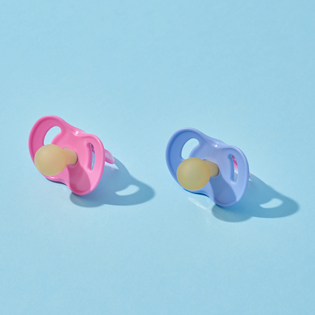A small, tender lump in your breast usually sends up a major red flag. But if you're breastfeeding, there's a good chance you're dealing with a clogged or plugged milk duct.
Though they can be uncomfortable, clogged ducts aren't cause for panic. But you will need to take action to get things flowing again — and know the possible signs that your clog is getting worse.
What are clogged milk ducts?
When you're breastfeeding, milk flows through your breasts in a pipe-like system of ducts. If a duct gets blocked or milk has trouble flowing through, a clog can form, which is known as a clogged or plugged duct. The result is a small lump in your breast that might look a little red and may feel sore or tender when you touch it.[1]
What causes a clogged milk duct?
Clogged ducts aren't uncommon, and they ultimately form when milk isn't emptied from your breast effectively. That can happen if:
- Your baby is having trouble latching or sucking. Both can cause her to take in less milk and irritate the duct.
- You miss or skip feedings or pumping sessions. Sometimes it's just the result of forgetting or having your baby sleep through her normal feeding time. But clogs can also happen because of abrupt changes in feeding schedules, like going back to work or weaning too quickly. Think of it like a pipe backing up.
- Your baby is in the NICU. Being separated from your baby means you may not be able to nurse as often.
- Wearing a too-tight bra or clothes. Both can restrict the flow of milk.
What are the symptoms of clogged milk ducts?
If you have a plugged milk duct, one of the first things you might notice is a small, hard lump in your breast that you can feel close to your skin. The lump might feel sore or painful when you touch it. You might also notice the area around the lump feels warm or looks red. Another telltale sign is when the discomfort gets a little better right after you nurse.
Read This Next
Can you spot a clogged duct from the outside of your breast? Sometimes. In some cases, clogs can cause a small white dot at the opening of the duct on your nipple. You might also notice that your milk looks thicker, grainy or stringy.
How do you unclog a milk duct?
Plugged ducts can be annoying and a little concerning if left untreated. The good news is that they tend to be easy to manage at home.
The key is acting quickly. Without treatment, a plugged duct can lead to a breast infection or worse, so take these steps to get the milk flowing again:
- Nurse, nurse, nurse. Not only is breastfeeding safe with a plugged duct, it's the best way to get rid of a clog. Offer your baby the affected breast firstan, and make sure she drains the breast thoroughly at each feeding. (Read: don't pull her off too quickly.) It might be a little painful at first, but you’ll likely find some relief after your baby feeds.
- Find the right position. Experiment with positions that use gravity to help drain more milk from the breast, like nursing on all fours with your baby positioned below you. Another option: Try to latch your baby so her chin and nose are pointing towards the clog, so her suction is aimed directly at the affected duct and the chin may also help massage the area.
- Switch it up. Change breastfeeding positions (from cradle to football to crossover) so all milk ducts get stimulated equally.
- Pump when you need to. If your baby isn't fully emptying your breast, finish the task by pumping until the milk comes out in slow drips instead of a steady stream. This should only take a few minutes.
- Loosen it up a bit. Sometimes, plugged ducts are aggravated by external pressure (e.g., from a too-tight shirt or bra). Make sure your bra is snug but not binding, and consider steering clear of underwire for the time being.
- Apply a little heat. Placing warm (not hot) compresses (e.g. a washcloth dipped in warm water) on the affected breast before each feeding can help get milk flowing. Another tactic: Stand under a warm shower stream, letting the water hit the spot for a few minutes. (Overstimulation can increase milk production and worsen the clogged duct situation.)
- Massage it away. Applying gentle pressure to the plugged duct both before and during a feeding can help loosen the clog. Try a circular motion on the outside of the breast and move in towards the lump. Resist the urge to overdo it, though, since that could lead to overstimulation or bruising.
- Make an appointment to see your doctor. Talk to your practitioner if the lump gets bigger, lasts for more than a few days or if you develop a fever or significant discomfort.
Clogged milk duct vs. mastitis: How can you tell the difference?
Clogged ducts that aren't treated can turn into mastitis, a painful infection. Mastitis needs medical treatment, so it's important to know which issue you might be dealing with. Fortunately, it's usually pretty easy to tell the difference.
You likely have a clogged duct if:
- You're not in pain, or the pain is only confined to the area around the lump.
- The area around the lump might be red, but your whole breast isn't red.
- Aside from the lump, you generally feel fine.
You likely have mastitis if:
- Your entire breast is tender, painful, swollen or red.
- You also have flu-like symptoms including a fever, achiness and fatigue.[2]
Call your health care provider right away if you suspect you have mastitis, since the infection usually needs treatment with antibiotics.
Can you continue breastfeeding if you have a plugged milk duct?
Not only can you keep breastfeeding, you absolutely should. Nursing often is the best way to unclog the duct and get the milk flowing again, so don't hold back.
In fact, avoiding or limiting feeding on the affected breast can actually make matters worse, causing more milk to back up and compound the clog.
How can you prevent clogged milk ducts?
Some women seem to be more prone to plugged ducts than others, and there's no surefire way to avoid them completely. But there are plenty of steps you can take to lower your risk as much as possible.
- Breastfeed often. Nursing at regular intervals — every two to three hours or so — prevents your breasts from becoming engorged, keeping potential clogs at bay. If you're away from your baby for longer or she sleeps through a feed, pump regularly to prevent a backup.
- Ease into schedule changes. If you're weaning (or partially weaning), focus on dropping one feed and waiting a few days before moving on to the next one. If you're getting engorged, pump enough to get relief and continue with your wean plan.
- Keep it low-pressure. Steer clear of tight bras or tops and avoid sleeping on your stomach, which can put pressure on your breasts and set the stage for clogs.
- Change up your nursing position. Switching it up regularly helps drain all of your ducts equally.
- Wash your nipples. If it seems like dried milk is blocking the openings of your nipples after a feeding, wipe them clean with a warm cloth. Avoid lotions that might clog the duct as well.
- Ask your doctor about taking lecithin supplements. The fatty substance, derived from soybeans or egg yolks, is thought to possibly make milk thinner and less "sticky," so it's less prone to clogging. While there's not much research to back this up, many nursing moms who are prone to clogs say that it helps, and lecithin is considered safe to take while breastfeeding.[3] Of course, you should always get the green light from your doctor before taking any new supplement.
- See a lactation consultant. Frequent clogs could be a sign that your baby isn't latching or sucking as well as she should be.
Clogged or plugged milk ducts can be a part of breastfeeding. But they're easy to treat at home — and the best way to get rid of them is to keep on nursing. As you work to drain the clog, just keep an eye on the situation to make sure it doesn't get worse. If you notice increased redness, pain, swelling or start to feel flu-like symptoms, you should give your doctor a call right away.












































 Trending On What to Expect
Trending On What to Expect





